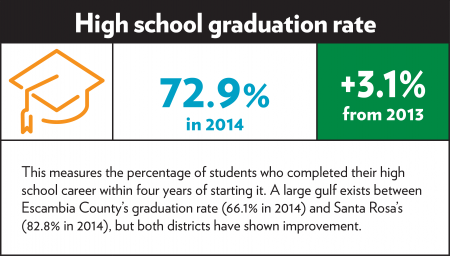Measuring Florida's progress on the Nation's Report Card
- October 29, 2015
- / Reggie Dogan
- / education

Students in Stacie Hammer’s fifth-grade class take a test at R.C. Lipscomb Elementary School.
The Nation’s Report Card on education showed mixed results in Florida in terms of proficiency in math and reading — with improvements in some areas and declines in others.
The state’s fourth-graders scored higher than the national average on math and reading, but eight-graders scored at or below national averages in reading and math.
On the bright side, low-income students in Florida, which has among the highest rates of low-income students in the nation, now rank in the top 10 in three of the four tested areas, including No. 1 in fourth-grade reading.
Florida’s low-income and Hispanic students also continued to outpace their peers in most other states.
The results show that fourth-grade Hispanic students had the nation’s highest percentage of students performing at or above Basic and at or above Proficient in reading, Florida Education Commissioner Pam Stewart announced.
“The 2015 National Assessment of Education Progress is one way we can measure the performance of our state’s students,” Stewart said in a release. “I am pleased that this year’s results show once again that we are a leader in the nation in these key subjects. This is a testament to the hard work of Florida’s educators in preparing our students and a reminder as to why we must remain committed to our robust education accountability system.”
The results of NAEP are released as The Nation’s Report Card and are available for the nation, states, and in some cases, urban districts. Every other year, the NAEP reading and math exams are given to a sample of students nationwide, with results published in the report card.
Duval, Hillsborough and Miami-Dade were the Florida school districts used in the NAEP. No other Florida school districts or schools were included in the national exam pool.
Locally, the most recent comparative scores for Escambia and Santa Rosa students are from FCAT 2.0. That data shows just over half — or 51 percent — of Escambia County eighth-graders scored proficient in reading and 46 percent in math.
For fourth-graders, 56 percent of Escambia students scored proficient in reading, and 55 percent in math.

Students in Tim Larick’s math class use smart boards to answer questions at Bellview Middle School. Larick is preparing his class for the Florida Standards Assessment, the new state standardized test that replaces the FCAT in April. The new test is expected to be more rigorous, slightly longer and mostly online. Photo credit: Michael Spooneybarger
In Santa Rosa County, 68 percent of eighth-graders showed proficiency in reading and 70 percent were proficient in reading. For fourth-graders, 73 percent of Santa Rosa students scored proficiency in both reading and math.
Proficiency at eighth grade is considered an important predictor for a students' likelihood of graduating high school. The high school graduation rate is one of the 16 community metrics in the Studer Community Institute's Pensacola Metro Dashboard.
The dashboard uses metrics developed with the University of West Florida to give a snapshot of the community's economic, educational and social well-being.
FCAT has been replaced by the Florida Standards Assessment — dubbed the FSA. Last year was the first year for the FSA. Results from that test are being distributed to districts and parents, but the cut scores — the benchmark for what counts as proficiency — has not been set by the Florida Department of Education.
Rolled out in 1969, NAEP is the largest continuing and nationally representative assessment of what our nation’s students know and can do in subjects such as mathematics, reading, science and writing. Standard administration practices are implemented to provide a common measure of student achievement.
Teachers, principals, parents, policymakers and researchers all use NAEP results to assess progress and develop ways to improve education in school districts around the country.
Each year students are randomly chosen to take hour-long tests in a various subjects. Every two years NAEP reports reading and math scores to measure national and state education trends and highlight several large school districts.
There is rising concern that a precipitous drop in scores on NAEP exam will pile on more complaints about the contentious Common Core Standards.
Both math and reading scores declined for the first sine the test changed to its current model in 1998.
Across the country, math scores dropped in both fourth-and-eighth grades, a first-ever decline on the exams.
Florida tied with Kansas and Pennsylvania for the biggest drop in eighth-grade math scores, as all lost six points on their average score compared to two years ago.
The state’s average eighth-grade math score was also below the average national score for public-school students.
For more information about Florida’s 2015 NAEP reading and math performance, visit The Nation’s Report Card.

 CivicCon launches with a look at good growth in cities
CivicCon launches with a look at good growth in cities
 Building stronger brains one baby, one parent at a time
Building stronger brains one baby, one parent at a time
 SCI debuts commercial on Early Learning City
SCI debuts commercial on Early Learning City
 Entrecon: World class speakers and an opportunity to sharpen skills
Entrecon: World class speakers and an opportunity to sharpen skills
 PYP Quality of Life survey 2017
PYP Quality of Life survey 2017
 EntreCon Pensacola 2016: A look back
EntreCon Pensacola 2016: A look back
 Leadership tip: getting better employee takeaways
Leadership tip: getting better employee takeaways
 Leadership tip: be interested instead of interesting
Leadership tip: be interested instead of interesting
 Leadership tip: delivering difficult messages
Leadership tip: delivering difficult messages
 Brain Bags boost Arc, Early Childhood Court programs
Brain Bags boost Arc, Early Childhood Court programs